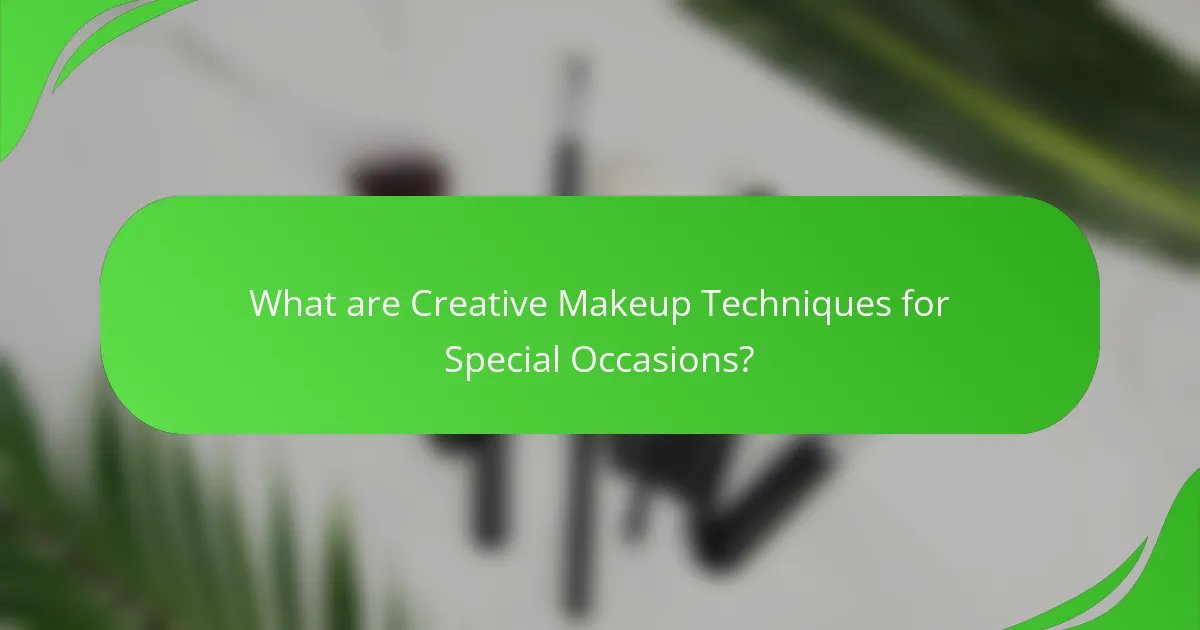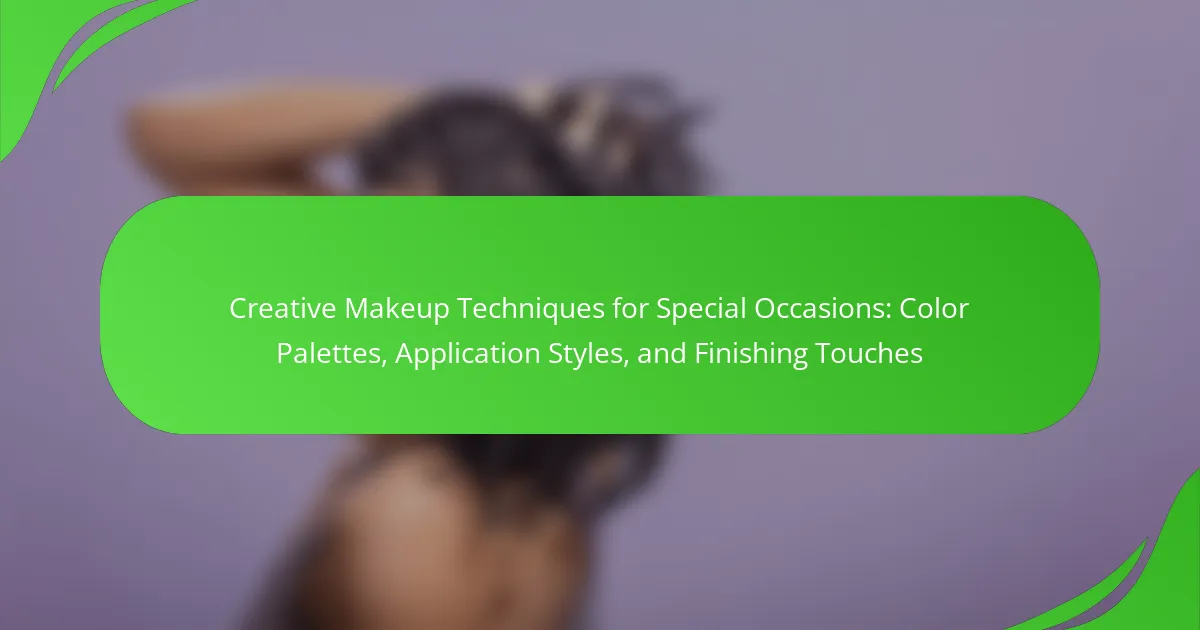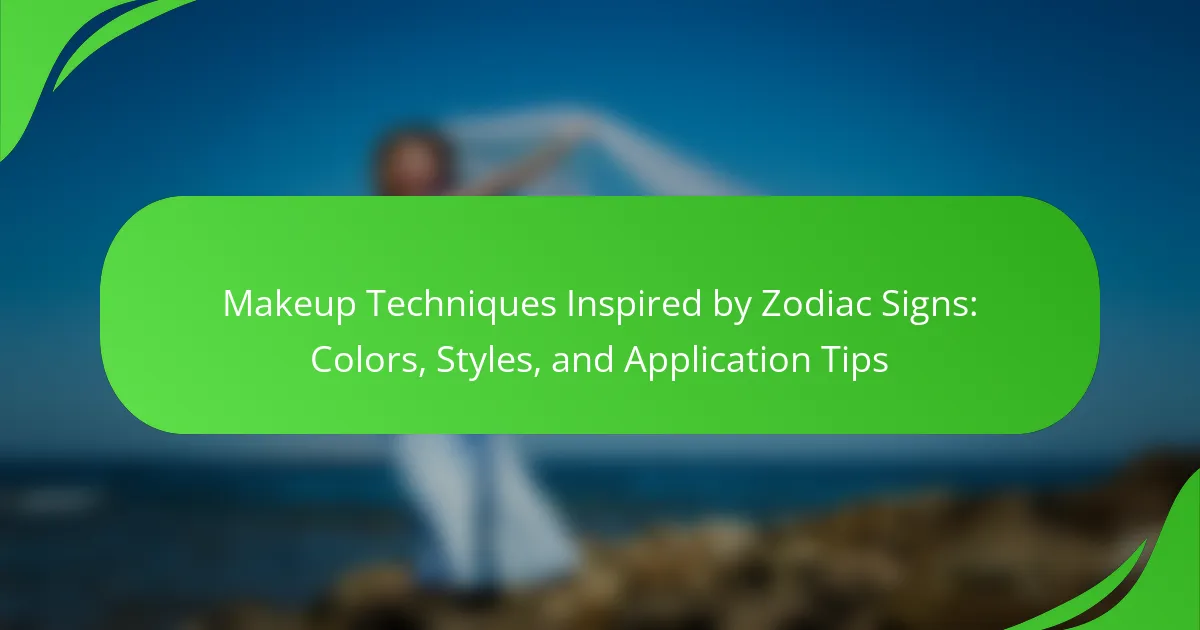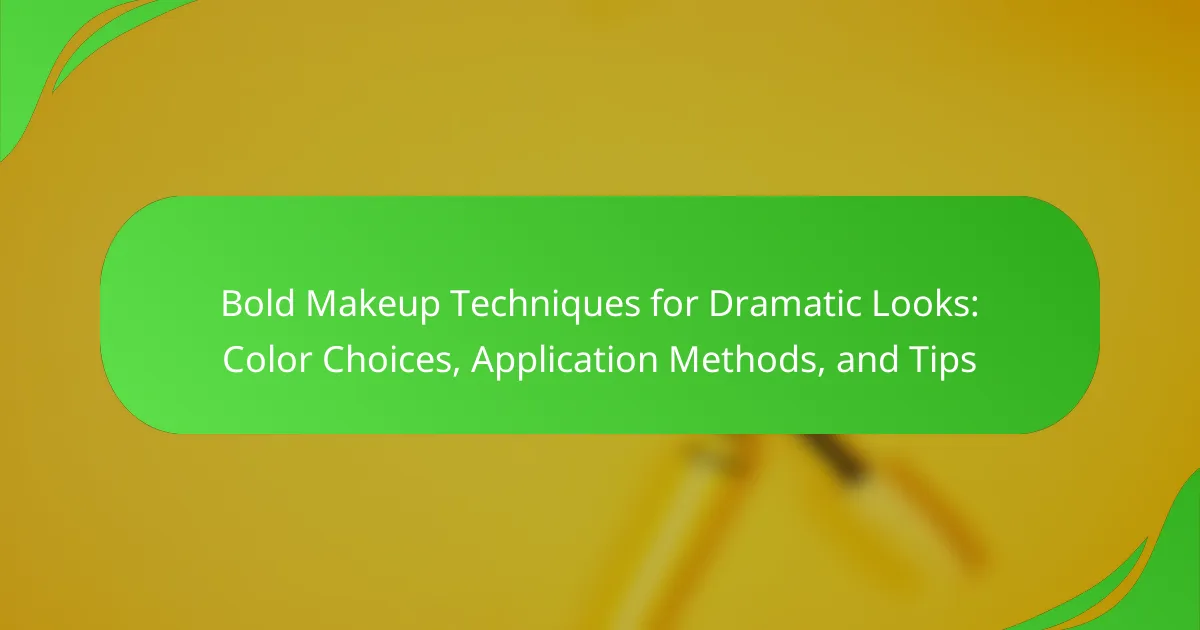Creative makeup techniques for special occasions encompass a variety of application styles and color palettes designed to enhance appearance and meet specific event needs. Key techniques include airbrushing for a flawless finish, glitter application for added sparkle, and bold eyeliner designs that create striking visuals. Additionally, contouring and highlighting techniques sculpt the face, while vibrant color palettes elevate the overall look. These methods are frequently utilized by makeup artists to achieve desired effects for events such as weddings, parties, and other special gatherings.

What are Creative Makeup Techniques for Special Occasions?
Creative makeup techniques for special occasions include techniques like airbrushing, glitter application, and bold eyeliner designs. Airbrushing offers a flawless finish and is ideal for events like weddings. Glitter can enhance eye looks or highlight features, adding sparkle and dimension. Bold eyeliner designs, such as graphic lines or colorful wings, create striking visuals. Techniques like contouring and highlighting can sculpt the face and enhance features. Additionally, using vibrant color palettes tailored to the occasion can elevate the overall look. These techniques are often employed by makeup artists to meet the specific needs of special events.
How do color palettes enhance creative makeup for special occasions?
Color palettes enhance creative makeup for special occasions by providing a cohesive visual theme. They allow makeup artists to select colors that complement each other. This creates harmony and balance on the face. Specific color combinations can evoke emotions and set a mood. For example, warm tones can create a festive ambiance, while cool tones can convey elegance. Additionally, color palettes help in highlighting features and creating depth. They guide the application of makeup products to achieve desired effects. Research shows that color theory plays a significant role in visual perception and aesthetics.
What are the most popular color palettes for different events?
Popular color palettes for different events include specific combinations tailored to occasions. For weddings, soft pastels like blush pink, lavender, and mint green are favored. Corporate events often utilize neutral tones such as navy blue, gray, and white for professionalism. Birthday parties typically feature vibrant colors like bright blue, yellow, and red to create a festive atmosphere. Seasonal events like autumn gatherings lean towards warm hues such as orange, burgundy, and gold. Holiday celebrations often embrace traditional colors; for example, red and green for Christmas, and black and orange for Halloween. Each palette enhances the event’s theme and mood, ensuring a cohesive visual experience.
How do color choices affect the overall look and feel?
Color choices significantly influence the overall look and feel of makeup. Different colors evoke various emotions and perceptions. For instance, warm colors like reds and oranges create a vibrant and energetic appearance. In contrast, cool colors such as blues and greens can convey calmness and serenity.
The choice of color can also enhance or diminish features. Bright colors can draw attention to specific areas, while muted tones can create a more understated look. According to a study by the University of California, color affects mood and can influence social interactions.
Thus, selecting the right color palette is essential for achieving the desired emotional response and visual impact in creative makeup techniques.
What application styles are commonly used in creative makeup?
Common application styles used in creative makeup include airbrushing, face painting, and layering techniques. Airbrushing provides a smooth finish and is often used for special effects. Face painting allows for intricate designs and is popular at events like festivals. Layering techniques involve applying multiple products for depth and dimension. Each style enhances the overall creative expression in makeup artistry.
How does the technique of blending impact the final appearance?
The technique of blending significantly enhances the final appearance of makeup. Blending creates a seamless transition between different colors and products. This technique reduces harsh lines, resulting in a more polished look. Effective blending helps to achieve a natural finish, making colors appear more cohesive. It also allows for better color saturation and depth. Proper blending can highlight features and create dimension on the face. According to makeup artists, well-blended makeup often looks more professional and aesthetically pleasing. Ultimately, blending is essential for achieving a flawless makeup application.
What are the differences between natural and dramatic application styles?
Natural application style emphasizes subtlety and enhancement of features. It aims for a fresh, effortless look. This style often uses neutral colors and minimal product. The goal is to create an appearance that feels light and breathable. Examples include light foundation, soft blush, and [censured] lips.
Dramatic application style focuses on boldness and statement-making. It often employs vibrant colors and heavy product use. This style seeks to create striking contrasts and defined features. Common elements include smoky eyes, bold lip colors, and contouring. The aim is to capture attention and create a memorable impression.
In summary, the primary difference lies in the intent and intensity of the makeup. Natural styles prioritize a polished but understated look. Dramatic styles embrace intensity and visual impact.
What finishing touches are essential for a polished look?
Essential finishing touches for a polished look include setting spray, highlighter, and lip gloss. Setting spray locks makeup in place and enhances longevity. Highlighter adds a radiant glow to cheekbones and brow bones. Lip gloss provides a glossy finish and can enhance lip color. These elements collectively create a refined appearance. Using these products can elevate the overall makeup look significantly.
How do highlighters and bronzers affect the overall makeup?
Highlighters and bronzers enhance overall makeup by adding dimension and warmth to the face. Highlighters create a luminous glow on areas like the cheekbones and brow bones. This effect draws attention and enhances [censured] features. Bronzers, on the other hand, provide warmth and a sun-kissed look. They are typically applied to the forehead, cheeks, and jawline. Together, these products contribute to a more sculpted and radiant appearance. The use of highlighters and bronzers can transform a flat makeup look into a vibrant and dynamic one. Their strategic application can also influence how light interacts with the skin, enhancing the overall aesthetic.
What role do setting sprays play in makeup longevity?
Setting sprays enhance makeup longevity by creating a protective layer over the applied products. This layer helps to lock in makeup, preventing it from fading or smudging throughout the day. Setting sprays often contain ingredients that help to absorb excess oil and moisture. This absorption reduces the chances of makeup breaking down due to environmental factors. Additionally, many setting sprays provide a matte or dewy finish, which can help achieve the desired look while maintaining wear. Studies have shown that makeup applied with a setting spray lasts significantly longer than without one. For instance, a study published in the Journal of Cosmetic Dermatology found that setting sprays can extend the wear time of makeup by up to 16 hours.
How can you transition between different makeup styles for various occasions?
To transition between different makeup styles for various occasions, start by assessing the event’s formality. For casual outings, opt for a natural look with minimal products. Use a tinted moisturizer, light blush, and a [censured] lip. For daytime events, add a touch of color with a soft eyeshadow and mascara. Transitioning to evening looks requires bolder colors and defined features. Incorporate a darker eyeshadow, eyeliner, and a statement lip color. For formal occasions, enhance the look with contouring and highlighting techniques. Use a full-coverage foundation and set with powder for longevity. Each transition should consider the lighting and setting of the event. This approach ensures makeup complements the occasion while enhancing personal style.
What specific techniques can elevate your makeup for special events?
Using specific techniques can significantly elevate your makeup for special events. Start with a flawless base by using a high-quality primer to smooth the skin. Apply a full-coverage foundation for a polished look. Use a color-correcting concealer to address any blemishes or dark circles. Enhance your features with contouring and highlighting for dimension. Choose bold eyeshadow colors that complement your outfit. Apply false lashes or volumizing mascara for dramatic eyes. Finish with a long-lasting setting spray to ensure makeup stays intact. These techniques are widely recognized in professional makeup artistry for their effectiveness in creating stunning looks for special occasions.
What are the best practices for applying makeup for special occasions?
The best practices for applying makeup for special occasions include starting with a clean and moisturized face. Use a primer to create a smooth base. Choose a foundation that matches your skin tone for an even complexion. Apply concealer to cover any blemishes or dark circles. Use setting powder to keep makeup in place. Select a color palette that complements your outfit and skin tone. Blend eyeshadows seamlessly for a polished look. Finish with a long-lasting setting spray to ensure durability. These practices enhance the overall appearance and longevity of makeup during special events.
How can you ensure your makeup lasts throughout the event?
Use a quality primer before applying makeup to ensure longevity. Primers create a smooth base and help makeup adhere better. Choose a long-wear foundation that is resistant to fading. Set your foundation with a translucent powder to lock it in place. Use setting spray after completing your makeup to enhance durability. Blotting papers can help manage shine without disturbing the makeup. Avoid touching your face throughout the event to prevent smudging. These methods are proven to extend makeup wear time significantly.
What common mistakes should be avoided when applying creative makeup?
Common mistakes to avoid when applying creative makeup include not prepping the skin properly. Skipping moisturizer or primer can lead to uneven application. Using the wrong colors for skin tone often results in an unflattering look. Over-applying products can create a heavy appearance, detracting from the intended design. Neglecting to blend well can leave harsh lines that disrupt the overall effect. Failing to set makeup properly with powder or setting spray may cause it to smudge or fade. Lastly, not considering the lighting can affect how colors appear, potentially leading to unintended results.
Creative makeup techniques for special occasions encompass various methods, including airbrushing, glitter application, and bold eyeliner designs, aimed at enhancing visual appeal for events like weddings and parties. The article explores how color palettes can create cohesive looks, evoke emotions, and influence the overall aesthetic, with specific palettes recommended for different occasions. Additionally, it covers application styles, the importance of blending, and essential finishing touches, such as highlighters and setting sprays, that contribute to a polished appearance. Best practices for makeup application and common mistakes to avoid are also discussed to ensure longevity and effectiveness in achieving desired looks.


